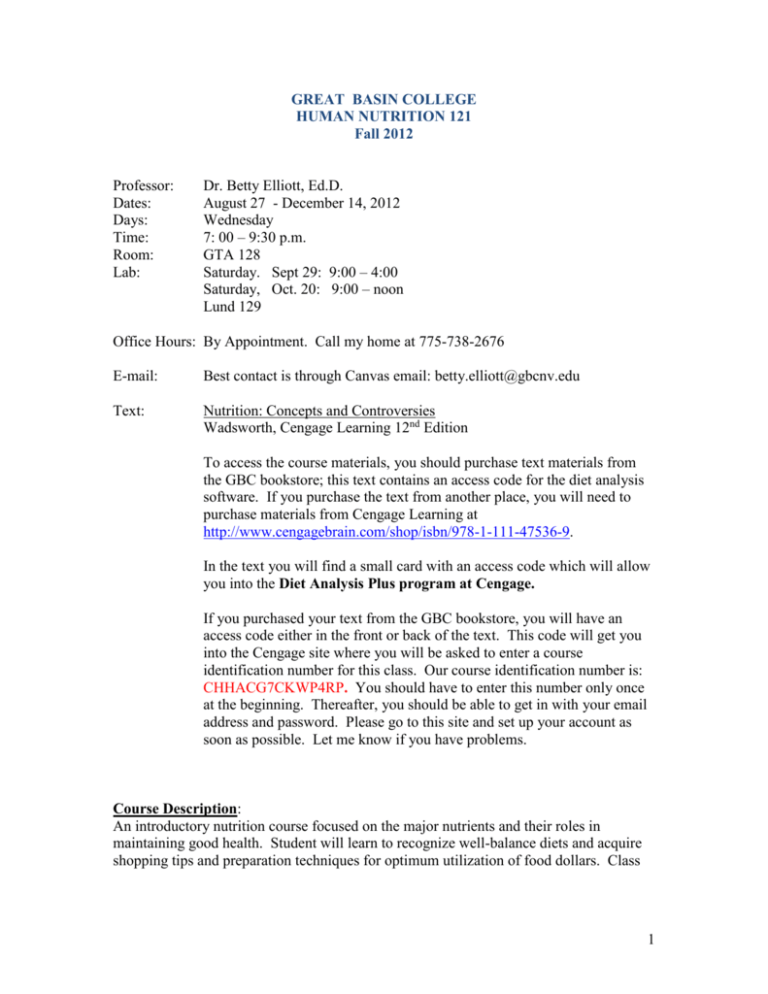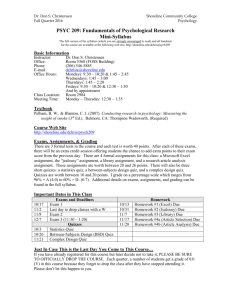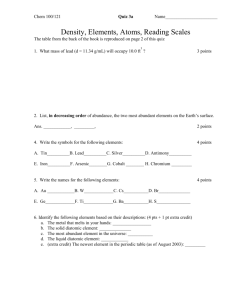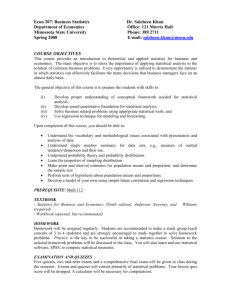NUTR 121 - Great Basin College
advertisement

GREAT BASIN COLLEGE HUMAN NUTRITION 121 Fall 2012 Professor: Dates: Days: Time: Room: Lab: Dr. Betty Elliott, Ed.D. August 27 - December 14, 2012 Wednesday 7: 00 – 9:30 p.m. GTA 128 Saturday. Sept 29: 9:00 – 4:00 Saturday, Oct. 20: 9:00 – noon Lund 129 Office Hours: By Appointment. Call my home at 775-738-2676 E-mail: Best contact is through Canvas email: betty.elliott@gbcnv.edu Text: Nutrition: Concepts and Controversies Wadsworth, Cengage Learning 12nd Edition To access the course materials, you should purchase text materials from the GBC bookstore; this text contains an access code for the diet analysis software. If you purchase the text from another place, you will need to purchase materials from Cengage Learning at http://www.cengagebrain.com/shop/isbn/978-1-111-47536-9. In the text you will find a small card with an access code which will allow you into the Diet Analysis Plus program at Cengage. If you purchased your text from the GBC bookstore, you will have an access code either in the front or back of the text. This code will get you into the Cengage site where you will be asked to enter a course identification number for this class. Our course identification number is: CHHACG7CKWP4RP. You should have to enter this number only once at the beginning. Thereafter, you should be able to get in with your email address and password. Please go to this site and set up your account as soon as possible. Let me know if you have problems. Course Description: An introductory nutrition course focused on the major nutrients and their roles in maintaining good health. Student will learn to recognize well-balance diets and acquire shopping tips and preparation techniques for optimum utilization of food dollars. Class 1 includes four required labs that will be taught by Kara Coates (Elko, Ely, and Battle Mountain), Doug Hogan (Winnemucca), and Jim Fitzgerald (Pahrump). Student Outcomes: General Education Student Learner Outcomes It is the goal of the faculty of Great Basin College that all students that graduate with either an Associate or Bachelor’s degree from this institution have had the opportunity presented to them during their attendance to have acquired ability and awareness with the following objectives: 1. Communications Skills: students will be able to communicate clearly and effectively in written and oral form, embracing discussion, reading, listening, and accessing information. Communication Outcomes Discuss or summarize nutritional concepts, either in writing or in person, using the appropriate vocabulary and relevant research findings. Conduct four laboratory exercises and report upon the procedures and results in the prescribed format in such a way that the reader can identify the purpose of the experiments, the results, and the conclusions. Collect information from electronic, print and live sources Evaluate the validity of the nutrition information collected Organize information into a usable format Measurement of Communication Outcomes: Class participation, lecture exams, lab reports, access electronic and print media, quizzes 1. Students will participate in class discussions, using appropriate vocabulary to present ideas, beliefs, values, or knowledge to contribute to the discussion. 2. Students will provide a written response to essay questions on each lecture exam using a standard rubric. 3. Students will report on each of the four laboratory sessions using the format and rubric as provided by the instructor. 4. Students will pass a quiz at the beginning of each laboratory. 5. Students will cite appropriate electronic and print information resources. 6. Laboratory write-ups will be organized in the correct format with results displayed according to MLA standards. 2. Critical Thinking: students will integrate creativity, logic, quantitative reasoning, and the hierarchy of inquiry and knowledge in social scientific understanding. Critical Thinking Outcomes: Assess a dietary pattern to determine the adequacy of nutrient intake to maintain a healthy body, taking into consideration age and lifestyle of the individual. Use scientific research to explain nutritional concepts. 2 Utilizing standard laboratory procedures, apply the scientific method by developing a hypothesis, conducting experiments, tabulating results in table and graph form, and presenting conclusions in a research format. Apply appropriate mathematical operations to problems and achieve correct solutions. Evaluate validity of scientific findings and their sources in explaining the relationship between nutrition, disease and health. Measurement of Critical Thinking Outcomes: Assignments, lecture exams, lab exercises, diet history assignment, class participation. 1. Conduct an assessment of his/her dietary intake of specific nutrients and compare to the recommended dietary standards, identifying those above or below the standards, and stating how the diet might be modified to conform to the standard. Each student will demonstrate this assessment in class. 2. Earn a passing score on lecture exams 3. Conduct four science labs, using correct procedures, to examine the chemical and physical properties of foods. 4. Test a food for evidence of enzyme activity and determine the effects of temperature, concentration, and substrate on the activity level. 5. Conduct, and report results and conclusion of a lab experiment. 6. Complete a three-day dietary record and analyze it for nutritional content. 3. Personal/Cultural Awareness: students will understand the roles of individuals in society, the development of human societies, and significance of creativity in the human experience. Personal/Cultural Awareness Outcomes: Students will recognize the roles of individuals, families, communities, and society as they impact nutritional status. Students will recognize the influence of personal beliefs, values, economic, and psychosocial factors on food choices Students will recognize personal biases regarding physical health and wellness in themselves and others Measurement of Personal/Cultural Awareness outcomes: Lecture exams, lab reports, class participation, assignments. 1. Students will identify cultural, personal, psychosocial, and economic factors that influence food choices on lecture exams and in assignments. 2. Students will state how dietary requirements change throughout the life span on lecture exams. 4. Personal Wellness: students will develop knowledge, skills, and behaviors which promote personal well being. 3 Personal Wellness Outcomes: Assess dietary patterns to determine the adequacy of nutrient intake to maintain a healthy body. Recognize personal biases regarding physical health and wellness in themselves. Make recommendations on how to correct dietary deficiencies in a diet for themselves, a child, a teen, and a senior citizen. Measurement of Personal Wellness outcomes: lecture exams, assignments, pre and post class diet survey, class participation 1. Scores earned on lecture exams. 2. Students will identify personal factors that influence food choices in the 3-day diet history, state whether there are health risks associated with the pattern of intake, and state how to correct nutritional deficiencies, if any. 3. Students will complete a pre and post class diet survey to assess the level of nutritional knowledge, skills, and behaviors which are known to promote health and compare the results 5. Technological Understanding: Students will function effectively in modern society through the use of technology. Technological Understanding Outcomes: Use basic computer technology competently to complete assignments. Students will use scientific equipment in appropriate and correct manner. Measurement of Technological Understanding: Lecture exams, lab exercises, online discussions, diet history assignment. 1. Students will access supplementary materials from the instructor’s webpage. 2. Students will complete the lecture exams online. 3. Lab assignments will be typed and formatted according to instructions. 4. Students will use appropriate websites for dietary information and analysis. 5. Students will perform the laboratory assignments as instructed using correct equipment to obtain results. 6. Communicate with instructor online or in person to complete assignments. Course Objectives: Upon completing Human Nutrition 121, student will be able to: 1. define terms common to a discussion of a nutritional topic; 2. identify the six major categories of nutrients and discuss how the roles of the nutrients in each of those categories affect health status; 3. describe how foods are grouped in the Daily Food Guide; 4. discuss how the Food Guide Pyramid provides guidance to achieving adequacy and balance in food choices; 5. describe mechanical and chemical digestion of food; 4 6. 7. 8. 9. 10. 11. identify and compare nutritional needs and problems of various age groups (infants through seniors); identify common nutritional deficiencies in the United States among various age groups and ethnic groups and discuss treatment modalities; demonstrate an understanding of the concepts of energy balance and physical activity; discuss the role of nutrition in disease prevention and health promotion; state the basic concepts of safe food handling; apply the principles of nutritional assessment, demonstrating data collection and interpretation, including elementary statistical concepts. Course Requirements: This course has two components: the lecture, which meets for two and one-half hours each week on Thursday, and three three-hour labs which meet on Saturday, October 15 (10:00 – 4:00) and Saturday, November 5 (10:00 – 1:00). The labs are an integral part of the course since the course fulfills a science requirement in the general education degree requirements at GBC. In order to pass the course, you must participate in all aspects of the course: lecture attendance, assignments, exams, laboratory attendance and reports. Method of Instruction: This course is primarily taught through lecture, discussion, and assignments which require students to apply the information covered in lectures and discussion. You are encouraged to read the assigned reading prior to the lecture and each laboratory exercise, so that you might benefit fully from the discussion and ask questions that may arise while you study alone. Your text has been bundled with a software application that will be used extensively throughout the course. If you purchase your text through GBC bookstore, you will receive the software with the text. If you purchase your text from another source, you will need to purchase the software from Cengage. The course key numbers for both the student companion sites for the text and the Diet Analysis+ program are listed at the top of the syllabus. If you need help, please call me. The labs are designed to reinforce and demonstrate the application of concepts discussed in lecture. They will be interesting and give you a chance to “see” science at work in the laboratory. The labs are posted on WebCampus so you need to print them out prior to the scheduled lab date and read the experiments ahead of time. At the beginning of each lab, you will take a 10 point lab quiz on the lab topic prior to doing the lab, so READ the LAB BEFORE the Lab so you will know what you are doing. Attendance: Since you have paid good, hard-earned money for the course, I anticipate that you will want to get your money’s worth by attending class. I will take roll, with excessive absences noted in the event that a final grade is border-line. While the text contains the theory content of nutrition, class discussions will make the information come to life as it 5 is discussed within the context of our day-to-day lives. Should you need to miss class to observe a religious holiday, please notify me prior to the holiday absence as this constitutes an excused absence per GBC policies? Exams: There will three lecture exams, each worth 100 points, scheduled in the syllabus, for a total of 300 points. Unless there is a clear, documented reason, students are expected to take the exam at the scheduled time. The exams will be taken online during the scheduled week. Sometimes, life is uncertain. If you have a serious situation that interferes with the class schedule, please give me a call or email and let’s discuss it. If you know in advance that you will be unable to take an exam, I would prefer that you take it early. Communication between us is important as we are partners in this endeavor. It is important that you give me feedback on how you (and I) are doing in the course. If you have questions, you must let me know. As I believe, “it’s not what the teacher is teaching that counts, but what the student is learning.” So, let me hear from you early and often. Assignments: Lecture Component: Quizzes: Every week there will be a chapter quiz of 10 points. The quiz will be taken online and automatically submitted to me. The quiz will be opened for you to take the day after class (Friday morning) and will close the following Wednesday at 11:30 p.m., giving you six days to take each chapter quiz. You may take it at your convenience, but only one time. There will be a time limit of twenty minutes to take the quiz. I would suggest that you take the review quiz for each chapter and practice quizzes in the supplementary material. There will be 14 quizzes for a total of 140 points possible for the chapter quizzes. Assignments: Each week there will be an assignment appropriate for the chapter topic. The assignments will vary in approach and are designed to help you learn much about your diet and health. The assignments’ point value will vary, but the total point value of assignments will be 145. We will use the Diet Analysis+ software included with your text for a number of the chapter assignments which you will complete online and automatically submit to me. I will assist you in the steps for using the technology available with the class. Lab Component: As mentioned earlier, there are three laboratory sessions scheduled on Saturdays. Prior to beginning each lab exercise, there will be a short quiz on the lab exercise ( 10 points) to insure that you have read and understand the lab you are about to conduct. Lab attendance is mandatory and lab activities will constitute 25%of the final course grade. Each of the three lab write-ups is worth 40 points for a total of 120 points, making each lab worth 50 points. 6 The comprehensive 3 – day Diet Analysis (Lab #4) is worth 50 points bringing the total lab points to 200 out of the 700 possible. You will use the Diet Analysis+ software that has been bundled with your text for this assignment. The instructions and questions to be answered for Lab #4 can be printed out, completed, and submitted to me via WebCT Policy of Academic Integrity: A GBC student is expected to conduct him or herself in accordance with college standards. The GBC catalog contains the Student Conduct Policy and prohibits certain specific behaviors, including academic dishonesty, cheating, and plagiarism, falsifying research data and results, and assisting others to do the same. In this course, there will be amply opportunity to work together, and those times that I will expect your work to represent your efforts alone. Accommodations: Students with documented physical or learning disabilities have the right to free accommodations to ensure equal access to educational opportunities at Great Basin College. For assistance, contact the Student Services Office at 753-2279. Any student needing special accommodations should notify me immediately. Grading Policy: During the course you will earn points for all of the activities in the class. This means that completing the chapter quizzes and exercises can positively influence exam scores as well as your final course grade. Points will be earned for the following activities and exercises: Lecture Chapter quizzes 14 @ 10 points = 140 Chapter exercises = 166 3 Exams @ 100 pts. each = 300 Lab 606 200 Lab reports: 3 @ 40 points each = 120 Lab Quizzes: 3 @ 10 points each = 30 Diet Analysis = 50 Total Points 806 The final grade will be determined by the percentage of the points earned in the entire course, lecture and lab combined, according to the following scale: A B C D F or W* 90% - 100% 80% - 89% 70% - 79% 60% - 69% Below 60% 725 – 806 points 644 - 724 points 564 – 643 points 483 - 563 points 000 – 482 points 7 GBC Catalog, “If you do not formally withdraw by the end of the 13th week of instruction, your instructor may assign a grade of “F” to your grade report. 8 CLASS SCHEDULE Week Date Lecture Topic Assignments 1 Aug. 29 Course Introduction Food Choices and Human Health 1) Set up your personal profile in Diet Analysis + (DA+). (10 pts.) 2) With paper and pencil, record everything you eat and drink for three days; two days should be week days and one day, a weekend day. Be honest and careful, estimating amounts of foods and beverages consumed. Include condiments, gravies, sauces, sugar, etc. Enter this information into ‘Track Diet’ in the DA+ program. 3) view the tutorial in DA+ and answer the one question. Chapter 1 Chapter Quiz (#1) 2 Sept. 5 Nutrition Tools – Standards and Guidelines Chapter 2 Chapter Quiz (#2) DA+ - MyPlate Comparison (13 pts.) 9 3 Sept 12 The Remarkable Body Chapter 3 Chapter Quiz (#3) DA+ - Lab: Food Label 1(10 pts.) View Pop-up tutorials: GI Tract, Absorption in the Small Intestine and Circulation 4 Sept. 19 Carbohydrates: Sugar, Starch, Glycogen and Fiber Chapter 4 Chapter Quiz (#4) DA+ - Carbohydrates (10 pts.) Internet Assignment: Complete the Diabetes Risk Test 4-5 (5 pts.) 5 Sept. 26 The Lipids: Fats, Oils, Phospholipids, and Sterols Chapter 5 Chapter Quiz (#5) DA+ - Lipids (14 pts.) View Popup tutorial: Lipoproteins 5 Sept. 27 – Oct. 2 EXAM #1 Chapters 1,2,3,4,5 6 Oct. 3 Chapter 6 Chapter Quiz (#6) DA+ - Proteins (12 pts.) The Proteins and Amino Acids 10 View Pop-up Tutorial: Protein Synthesis 7 Oct. 10 The Vitamins Chapter 7 Chapter Quiz (#7) DA+ - Vitamin Intake (14 pts.) 8 Oct. 17 Water and Minerals Chapter 8 Chapter Quiz (#8) DA+ - Calcium Intake (12 pts.) 9 Oct. 24 Energy Balance and Healthy Body Weight Chapter 9 Chapter Quiz (#9) DA+ - Energy Balance (10 pts.) Complete the Case Study (5 pts.) 9 Oct. 25 –Oct. 30 EXAM #2 Chapters: 6,7, 8, 9 10 Oct. 31 Chapter 10 Chapter Quiz (# 10) Nutrients, Physical Activity, And the Body’s Responses 11 Go to RealAge.com and answer the questions provided in the module 11 Nov. 7 Diet and Health Chapter 11 Chapter Quiz (#11) Internet Assignment: Disease Risk 3-5 (from chapter 3) (10 pts.) 12 Nov. 14 Food safety and Food Technology Food Safety Video Hand Washing Demo Testing the Environment for Bacteria Chapter 12 Chapter Quiz (# 12) Assignment: (10pts.) View Video: Food Safety Begin Lab #4 13 Nov. 21 Life Cycle Nutrition: Mother and Infant Chapter 13 Chapter Quiz (# 13) Assignment: Questions 1-4 (10 pts.) Work on Lab # 4 14 Nov. 28 Children Chapter 14 Assignment: Question (10 pts.) Lab # 4 Due 12 15 Dec. 5 Teens and Older Adults Chapter Quiz # 14 (10 pts.) 15 Dec. 6 – 13 EXAM # 3 Chapter s: 10,11, 12, 13, 14 13





